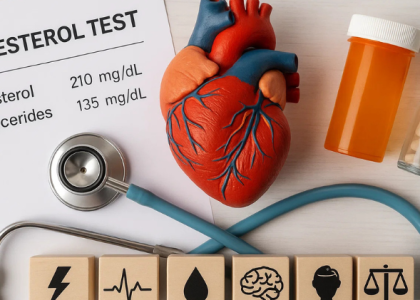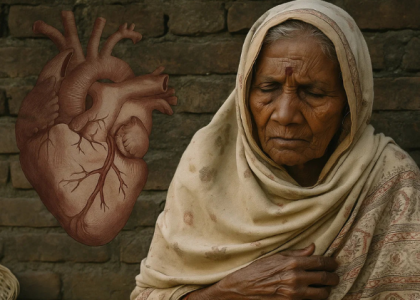The 16-Hour Question: Can Fasting Help Your Heart?
If you’ve heard your cousin say, “I only eat between noon and 8,” or watched YouTube videos about skipping breakfast to burn fat — you’re not alone. Intermittent fasting has exploded in popularity. And many South Asians are wondering: Does this actually work for us?
More importantly: Can it reduce our risk of heart disease, diabetes, or belly fat?
The short answer: Yes — but with important considerations.
Let’s unpack what intermittent fasting is, how it affects South Asian bodies, and whether it’s the right approach for your heart.
What Is Intermittent Fasting (IF)?
Intermittent fasting (IF) isn’t about what you eat — it’s about when you eat.
The most popular version is:
- 16:8 method – Fast for 16 hours, eat during an 8-hour window (e.g., eat from 12 PM to 8 PM, fast from 8 PM to 12 PM the next day)
There are other variations (like 14:10 or 5:2 fasting days), but 16:8 is the most common.
During the fasting period:
- You can drink water, black coffee, or tea (without milk/sugar)
- You avoid food, milk, or calorie-containing drinks
How IF May Improve Heart Health — Especially for South Asians
Research shows that intermittent fasting can improve key heart health markers, especially in people prone to:
- High belly fat
- Insulin resistance
- Fatty liver
- Inflammation
That’s most of us.
Here’s what happens inside your body when you fast:
- Insulin levels drop – Helps burn fat and improve blood sugar control
- Belly fat shrinks – Visceral fat reduces faster during fasting
- Inflammation decreases – Lower CRP (a marker of heart inflammation)
- Cholesterol improves – Especially triglycerides and LDL particle size
- Blood pressure drops – Modestly, but meaningfully
For South Asians, who develop heart disease at younger ages and at lower BMIs, fasting can act like a metabolic reset.
But Wait — What About the Indian Diet?
Here’s the challenge: Many South Asians break their fast with white rice, fried snacks, sugar chai, or parotta.
That defeats the purpose.
Fasting works only if your meals are balanced. Here’s how to do it right:
What to Eat After Fasting (To Help Your Heart)
Best first meal (at 12 PM):
- Protein: 2 boiled eggs, dal, tofu, or grilled paneer
- Fiber: sautéed spinach, cabbage, bhindi, or beans
- Slow carbs: small serving of brown rice, quinoa, or millet
Worst first meal:
- White rice with sambar only
- Deep-fried vadas, banana chips, or sweets
- Sugary chai or coffee
Fasting improves insulin — but if you spike it with sugar immediately, you undo the benefits.
How to Adapt IF for South Asians (Without Burning Out)
Let’s face it — we’re a family- and food-loving culture. Fasting should feel empowering, not extreme. Try these culturally mindful strategies:
Start with a 14:10 window
- Eat from 9 AM to 7 PM for a week
- Then shift to 10 AM to 6 PM
- Eventually try 12 PM to 8 PM
This gradual approach is easier for beginners — especially those who love morning tea or feel dizzy skipping breakfast.
Drink smart during your fast
- Plain water: always best
- Black coffee: OK
- Herbal teas: good
- Avoid: chai with milk/sugar, juices, fruit smoothies
Who Should Avoid or Modify Fasting?
Intermittent fasting is powerful — but not for everyone. Speak to your doctor first if you have:
- Type 1 or uncontrolled Type 2 diabetes
- A history of low blood sugar or fainting
- You’re pregnant, breastfeeding, or underweight
- You’re on multiple medications
- You have a history of eating disorders
Women, in particular, may benefit more from 12–14 hour fasts, especially around menopause.
Real-Life Success: South Asian Stories
- Ramesh, 52: “I started IF with 14:10. In 3 months, I lost 4 kg and my cholesterol dropped for the first time without meds.”
- Latha, 46: “I used to snack constantly while working. Now, I eat two balanced meals, and my belly has reduced.”
These are common outcomes — IF works best when paired with awareness and habit tracking.
Track What Matters — Not Just the Scale
While doing intermittent fasting, watch for:
- Decreased waist size
- Lower sugar cravings
- Better energy during the day
- Blood test improvements (sugar, triglycerides)
Take your waist measurement monthly — that’s your real scoreboard.
Final Takeaway
Intermittent fasting is not a miracle — but it’s a scientifically backed, culturally adaptable tool that helps reduce belly fat, insulin resistance, and heart risk.
For South Asians, especially men and women in their 40s and 50s, it can be a turning point — if done mindfully.
Skip the extremes. Start slowly. Break your fast with real food, not refined carbs. And remember — the goal isn’t just weight loss. It’s heart health.
So the next time someone asks, “Why are you skipping breakfast?” You can smile and say, “I’m feeding my future heart.”




